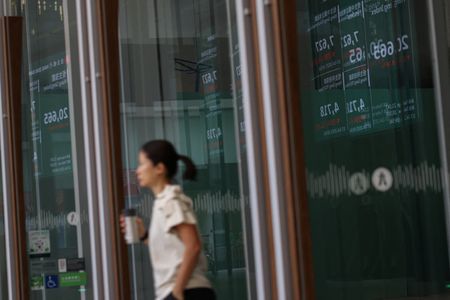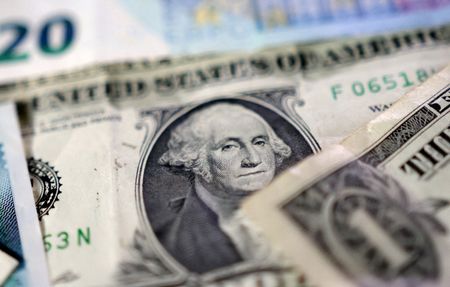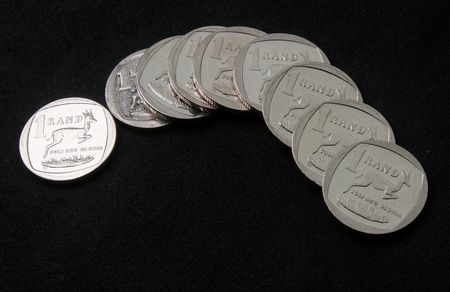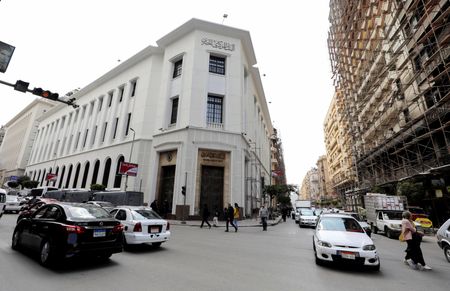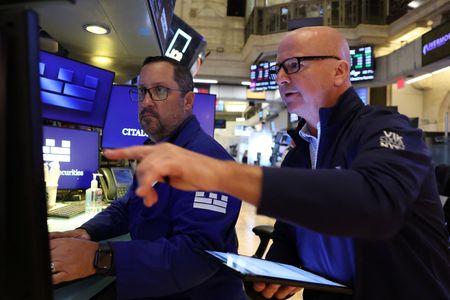By Caroline Valetkevitch
NEW YORK (Reuters) -Longer-dated Treasury yields gained while the dollar broadly eased on Monday amid concerns about the U.S. debt load and a tax-cut bill, following Moody’s downgrade of the country’s sovereign credit rating.
Major U.S. stocks indexes recovered from early losses to end the day flat to slightly higher.
Late on Friday, Moody’s Investors Service cut the United States’ sovereign credit rating from the top triple-A rank, highlighting the country’s deteriorating fiscal outlook.
U.S. President Donald Trump’s sprawling tax-cut bill was approved by a key congressional committee on Sunday. Republicans who control the U.S. House of Representatives will try to push the bill toward passage this week.
The 30-year Treasury yield hit an 18-month high before backing off those levels. Investors were concerned that the tax bill will increase the debt load by more than previously expected.
The 30-year bond yield gained 3.7 basis points to 4.934% after touching 5.037%, the highest since November 2023. The yield on benchmark U.S. 10-year notes rose 3 basis points to 4.469%, having earlier reached 4.564%, the highest since April 11.
“What Moody’s did was really more symbolic than anything else. The other agencies had already downgraded the debt,” said Peter Cardillo, chief market economist at Spartan Capital Securities in New York.
“Yes, yields are moving higher on the news… But they are moving up for other reasons as well,” he added. “In general the (stock) market is not really reacting all that much to the Moody’s announcement. Rather, it’s a market that’s come up and is looking to perhaps consolidate its recent moves.”
The downgrade from Moody’s follows similar moves from Fitch in 2023 and Standard & Poor’s in 2011.
U.S. Treasury Secretary Scott Bessent used television interviews on Sunday to dismiss the downgrade.
Some Federal Reserve officials on Monday commented on U.S. markets following the downgrade. Speaking at a conference held by the Mortgage Bankers Association in New York, New York Fed President John Williams said investors are “clearly” weighing future options.
Nevertheless, he said investors “have viewed and continue to view” the U.S. as “a great place to invest, including Treasuries, fixed income assets, so I think that that narrative is still there.”
The Dow Jones Industrial Average rose 137.33 points, or 0.32%, to 42,792.07, the S&P 500 rose 5.22 points, or 0.09%, to 5,963.60 and the Nasdaq Composite rose 4.36 points, or 0.02%, to 19,215.46.
The S&P 500 had registered its fifth straight day of gains on Friday.
MSCI’s gauge of stocks across the globe rose 1.77 points, or 0.20%, to 882.39. The pan-European STOXX 600 index rose 0.13%, while Europe’s broad FTSEurofirst 300 index rose 2.80 points, or 0.13%.
MSCI’s broadest index of Asia-Pacific shares outside Japan closed lower by 0.5%, with a mixed bag of Chinese data showed a struggling economy.
The U.S. dollar declined, hitting a more than one-week low against the safe-haven yen, Swiss franc and euro. Against the Japanese yen, the dollar weakened 0.55% to 144.82.
Trump’s tariff war has sapped consumer sentiment, and analysts will be scouring earnings from Home Depot and Target this week for an update on spending trends. Home Depot is due to report on Tuesday before the opening bell.
Trump said on Saturday that Walmart should “eat the tariffs” after the world’s largest retailer said it would have to start raising prices due to the levies.
Atlanta Fed President Raphael Bostic told CNBC on Monday the central bank may only be able to cut interest rates by a quarter point over the rest of the year given concerns about rising inflation stoked by higher import taxes.
Finance leaders from the Group of Seven democracies will strive for a show of unity when they meet this week on topics other than Trump’s tariffs, including economic security, Ukraine and artificial intelligence cooperation.
Oil prices ended slightly higher as signs of an impasse in U.S. talks with Iran over its nuclear program offset Moody’s downgrade.
Brent crude futures rose 13 cents to settle at $65.54 a barrel, while U.S. West Texas Intermediate crude rose 20 cents to settle at $62.69 a barrel.
Gold prices gained, with spot gold up 0.9% at $3,229.51 an ounce, while U.S. gold futures settled 1.5% higher at $3,233.5.
(Reporting by Caroline Valetkevitch in New York, with additional reporting by Samuel Indyk in London and by Wayne Cole; Editing by Richard Chang and Stephen Coates)


